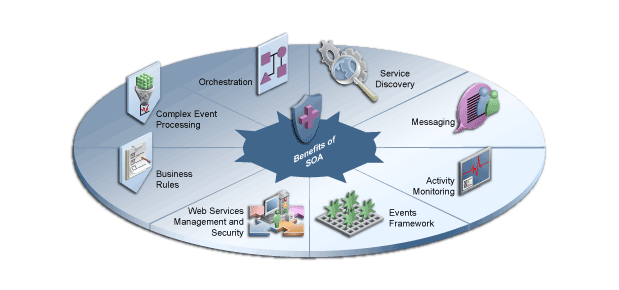
Introduction to Oracle SOA Suite
The components of Oracle SOA Suite benefit from common capabilities, including a single deployment, management, and tooling model, end-to-end security, and unified metadata management. Oracle SOA Suite is unique in that it provides the following set of integrated capabilities:
- Messaging
- Service discovery
- Orchestration
- Web services management and security
- Business rules
- Events framework
- Business activity monitoring
These capabilities help address the fragmented IT landscape and addresses the difficulties associated with silos of IT infrastructure and applications. It enables greater flexibility through:
- Interoperability: SOA, and the industry standards underpinning it, enable existing siloed applications to interoperate seamlessly and in an easier-to-maintain manner than any traditional EAI solution.
- Increased reuse: Once legacy systems and applications are service enabled, these services can be reused, which results in reduced ongoing development costs and results in reduced time to market. Further, business processes built as an orchestration of services can also be exposed as services, further increasing reuse.
- More agile business processes: SOA reduces the gap between the business process model and implementation. This enables changes to business processes already implemented as orchestrations of services to be easily captured and implemented.
- Improved visibility: SOA can give improved business visibility by enabling business capabilities exposed as services, and the status of in-flight business processes automated with business activity monitoring, to be rapidly integrated into service-enabled enterprise portals, aiding business decision-making.
- Reduced maintenance costs: SOA development encourages duplicated overlapping business capabilities (services) that span multiple applications and systems to be consolidated into a small number of shared services. SOA development enables elimination of redundant services and reduces the cost of maintaining systems by providing a single point of change for application logic. Further, SOA gives IT the means to gradually phase out legacy systems and applications, while minimizing disruption to the applications that are built on or are integrated with them using SOA principles. This process frees up funds for new projects.
- Compliance and governance: By realizing better and more standardized operational procedures, SOA provides the basis for a comprehensive security solution, and enables better visibility into business operations and exception conditions.